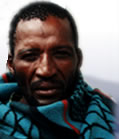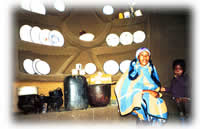 |
 |
||
 |
|||
|
RELATED THEMES agriculture development environment land social relationships OTHER LOCAL THEMES BACKGROUND |
history
quotes about historyThe testimony of one 90-year-old places his family's migration to the area in the 1930s: "the years of the dust". This is the phrase Basotho use to describe the time of the 1930s depression: this was the time when, just before a major drought took hold, the air was filled with dust - so thick that it obliterated the sunlight and people had to light candles during the day. "Yes, when he came and built here.. The ruins are in there, which actually has some poplar [trees]. The remains of our grandmothers are still in there; they kept coming later, and arrived here [during] the years of the dust." (Lesotho 7) One narrator (Lesotho 17b) points out that the present local chief's family are descendants of an immigrant chief called Tsapane who, after leaving Matatiele, settled in Mpharane in the Mohale's Hoek district for a while. It was the search for pasture that finally took him to the Mohale area where he set up an animal post. Within a short time of his arrival he tried farming, experimenting first with wheat and then maize. The results testified to the fact that the area had not only good pasture but also fertile crop land. "When he had set up an animal post here, it was then that he fetched a plough seeing this place being nice and then he planted wheat and he harvested a lot of wheat; and then he fetched the women from there because of that animal post of his. The women it happened that when they were here it happened that they now refused to go back there, seeing this prosperity here.. In the second year he put in maize.it was found out then that maize also was successful; and then it happened that people no longer moved and now this became a home and that was all.. They then built a village and then the village increased. It continued to happen that people kept coming from there, indeed most of these people come from up there." Reference is made to two instances of resistance in the past. One was during the collectivisation of villages in the 1940s and 1950s, when local people refused to abandon their villages. They were being asked to come together into larger communities, mainly to ease the provision of government services. "Those ones who remained there are the ones who went on strike. They refused to leave and hid among the precipices. They became wild cats in there. They used to come [to the village] in the evening when they came to eat." The other was the solidarity of the Basotho during the 1985 miners' strike in South Africa: "In 1985, there was a huge strike and all the Basotho mines stood united and decided not to go to work, unlike the Xhosas and the Zulus who continued to work and undermined our solidarity with Batswana and Shangani's. After this incident most of us came home but some remained in South Africa to work in the mines elsewhere." |
|
 For most narrators, links with the area go back to their grandparents. One says of his grandfather's decision to move and settle in Molika-liko, he
For most narrators, links with the area go back to their grandparents. One says of his grandfather's decision to move and settle in Molika-liko, he